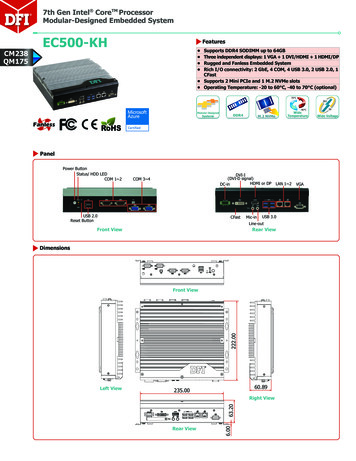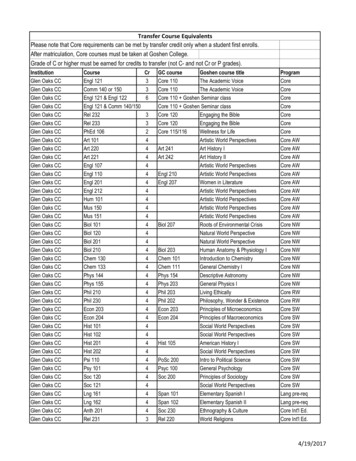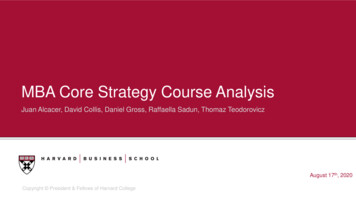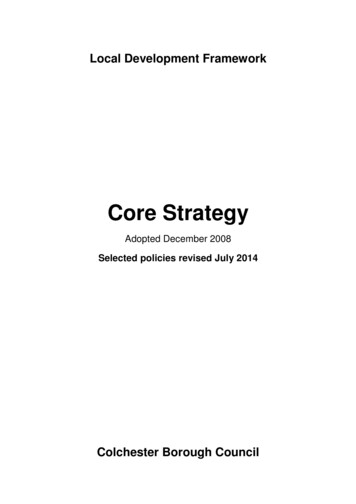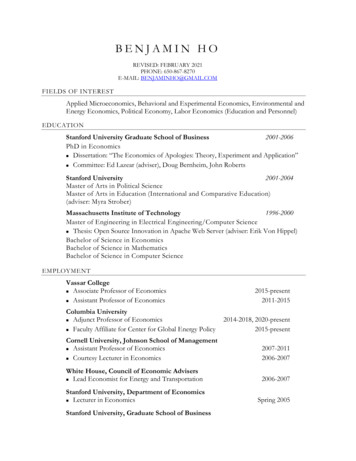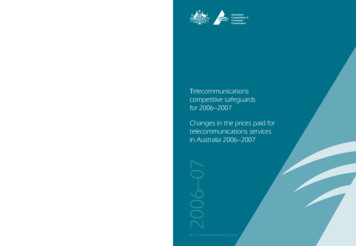
Transcription
Telecommunicationscompetitive safeguardsfor 2006–20072006–07Changes in the prices paid fortelecommunications servicesin Australia 2006–2007ACCC telecommunications reports
ACCC telecommunications reports2006–07This publication contains two reports:Report 1Telecommunications competitive safeguards for 2006–07Report 2Changes in prices paid for telecommunications servicesin Australia, 2006–07
Commonwealth of Australia 2008ISBN 978 1 921393 73 0This work is copyright. Apart from any use permitted by theCopyright Act 1968, no part may be reproduced withoutpermission of the Australian Competition and ConsumerCommission. Requests and inquiries concerning reproductionand rights should be addressed to the Director Publishing,Australian Competition and Consumer Commission, GPOBox 3131, Canberra ACT 2601.Produced by the ACCC 05/08.
The emerging competitive environment is encouraging carriers to invest, innovate andcompete for customers. Yet this emerging state of competition has not occurredwithout pressure on regulatory mechanisms. Industry has been progressively forced torely more on ACCC processes to resolve impasses in commercial negotiations foraccess to regulated services. 2006–07 saw the highest number of access disputesnotified in a single year, and continues the increasing trend for arbitration as amechanism for resolving industry disputes.Increased investment has enabled access seekers to differentiate their downstreamproduct offerings to compete more vigorously for retail customers. As a result, endusers are now able to access the internet using faster connections with increasingtheoretical maximum speeds over ADSL2 technology or upgrades to both Telstra’sand Optus’s HFC networks. The increased accessibility of competitive mobilebroadband internet is another recent innovation that is likely to contribute to futurechanges in consumer behaviour.Consumers are starting to reap the benefits of the investments and innovations madeby carriers. There is now a range of communications services available to consumersthrough an increasing number of access providers, over a range of differenttechnology platforms, at competitive price points. As the industry continues to evolve,it is important that the benefits of competition are preserved.The Australian Government has announced its intention to deliver a high-speednational broadband network to 98 per cent of Australians, increasing speeds to aminimum of 12 megabits per second (Mbps). The government has committed tomaking a public investment of 4.7 billion towards the new network, with thenetwork builder to be determined through an open and transparent process to be heldin 2008.Upgrading networks by pushing fibre closer to end users may mean that certaincurrently regulated bottleneck services, such as the ULLS and LSS may no longer beavailable, with subsequent implications for the effectiveness of competition intelecommunications markets. However, the ACCC considers that there are a range ofregulatory and institutional arrangements that could potentially satisfy thegovernment’s objectives for the national broadband network on price and opencompetition, and notes the government’s intention to enact legislative change ifrequired to achieve those objectives.Report 2—Changes in the prices paid for telecommunications services in AustraliaThe overall average price paid by consumers for telecommunications services fell inreal terms by 2.7 per cent in the 2006–07 financial year. Average prices paid forfixed-line services fell by 3 per cent and average prices for mobile services fell by 2.3per cent.The decline in average prices could have been influenced by several factors, includingproductivity gains in the telecommunications sector and greater price competitionfaced by providers of fixed-line services.
The fall in prices paid for fixed-line services was not reflected evenly across theresidential and business segments. Average prices paid by residential and businesscustomers fell by 1.6 per cent and 5.3 per cent respectively. As in previous years,price falls for businesses continued to exceed price falls for residential consumers in2006–07.Across the individual fixed-line services, price falls in 2006–07 for national longdistance and fixed-to-mobile have been the largest, with prices falling by 15.9 percent and 7.5 per cent respectively. The retail price decline for fixed-to-mobile servicescould have been affected by the declining cost of inputs—in particular, mobileterminating charges—as a result of the ACCC’s recent decisions on charges for themobile terminating access service.During 2006–07 the average price for basic access increased by 6.6 per cent, withaverage price for residential customers increasing by 11.5 per cent. The increase maybe a result of carriers passing on an increase in the price of wholesale basic access byTelstra to its customers. It could also be due to the introduction of subscription plans,which result in the associated revenues being reported against basic access.In mobile services retail markets, average prices paid by consumers fell by 2.3 percent in 2006–07. Prices for GSM services decreased by 2.7 per cent, while prices forCDMA services increased by 2.6 per cent.Prices paid for post-paid GSM services decreased by 6.5 per cent, while prices paidfor pre-paid GSM services increased by 2.4 per cent. In particular, the average pricesfor post-paid and pre-paid CDMA services increased by 2.9 per cent and 2.1 per centrespectively. As a result of the closure of the Hutchison (Orange) CDMA network inAugust 2006, the mobile index had to be re-weighted to provide an accurate accountof price changes for CDMA networks in 2006–07. The ACCC anticipates that 3Gmobile services will be included in the mobile service index in future reports.The ACCC is currently examining the appropriate methodology for estimatingmovements in internet service prices and it is anticipated that an internet servicesindex will be included in the 2007–08 report.Yours sincerelyGraeme SamuelChairman
List of shortened forms3Gthird generation mobile communicationsACMAAustralian Communications and Media AuthorityACompTAustralian Competition TribunalADSLasymmetric digital subscriber lineADSL2 extends the data capability of basic ADSL by using a greater frequencyband for the downstream direction for a particular geographic reachBCSbasic carriage servicesCANcustomer access networkCDMAcode division multiple accessCLLSconditioned local loop serviceCPIconsumer price indexcpmcents per minuteCSGcustomer service guaranteeCSPcarriage service providerDBCDEDepartment of Broadband, Communications and the Digital EconomyDCITA Department of Communications, Information Technology and the Arts(now known as the DBCDE)DDASdigital data access servicexDSLdigital subscriber lineDSLAMdigital subscriber line access multiplexersDTCSdomestic transmission carriage gigabits per secondGSMglobal system for mobilesHFChybrid fibre coaxialHSPAhigh speed packet accessISPinternet service providerISDNintegrated services digital networkACCC telecommunications reports 2006–07 REPORT 1vii
Kbpskilobits per secondLCSlocal call serviceLSSline sharing serviceLTIElong-term interests of end usersMbpsmegabits per secondMTASmobile termination access serviceMVNOmobile virtual network operatorNBNnational broadband networkNPTCnon-price terms and conditionsOECDOrganisation of Economic Cooperation and DevelopmentOSPoperational separation planPSTNpublic switch telephone networkPSTN OApublic switch telephone network origination accessPSTN O/TApublic switch telephone network origination/termination accessPSTN TApublic switch telephone network termination accessRAFregulatory accounting frameworkRKRrecord-keeping ruleSAOstandard access obligationsSAUspecial access undertakingsTEATelstra efficient access (Telstra cost model)TIOTelecommunications Industry Ombudsmanthe ActTrade Practices Actthe tribunalAustralian Competition TribunalTSLRIC total service long-run incremental cost plus an allocation of indirect overhead costsULLSunconditioned local loop serviceVoIPvoice over internet protocolW-CDMAwideband code division multiple access (also referred to as 3G)WLRwholesale line rentalviiiACCC telecommunications reports 2006–07 REPORT 1
Contents1 Summary.11.1 State of competition . 11.2 Anti-competitive conduct and consumer safeguards . . 21.3 Monitoring and reporting . 21.4 Access to telecommunication services . 31.5 Activities under the Telecommunications Act . 31.6 Activities under the Radiocommunications Act. 42 Overview of the state of competition in telecommunications markets . .52.1 Overview . 52.2 Investment . . 112.3 Markets analysis. 122.4 Voice services . . 132.5 Internet and data services . 253 Anti-competitive conduct provisions .343.1 Investigations conducted in 2006–07. 343.2 Exemption orders . . 363.3 Third line force notifications . 364 Consumer safeguard provisions .374.1 Investigations undertaken. 375 Monitoring and reporting .395.1 Efforts to reduce regulatory burden . . 395.2 Ongoing and new monitoring and reporting activities . 40
6 Access to telecommunications network services .466.1 Public inquiries into the declaration of telecommunications services . . 476.2 Exemptions from declaration. 496.3 Access undertakings . 516.4 Access disputes . . 546.5 Pricing principles and indicative pricing . 586.6 Procedural rules . 596.7 Development of models to estimate costs of providing services . 606.8 Telecommunications access code. 617 Activities under the Telecommunications Act . .627.1 Operational separation of Telstra . 627.2 Number portability . 637.3 Communications Alliance . . 637.4 Access disputes under the Telecommunications Act . 648 Activities under the Radiocommunications Act .658.1 Digital radio . . 658.2 Digital television . 66
Telecommunications competitivesafeguards for 2006–07May 2008
1SummaryUnder Part XIB, Division 11, s. 151 CL(1) of the Trade Practices Act 1974 (the Act), the AustralianCompetition and Consumer Commission (ACCC) is required to provide to the Minister for Broadband,Communications and the Digital Economy (DBCDE) an annual report on competitive safeguardswithin the Australian telecommunications industry.This report covers the financial year 2006–07 and ongoing actions immediately afterwards.All of the ACCC publications referred to in this report are available at www.accc.gov.au.The key findings of the report are outlined below.1.1State of competition2006–07 saw the highest level of investment in telecommunications since the sector was openedup to competition in 1997. During the period carriers announced, or commenced investment in,expanding and/or improving the data capability of their 3G mobile networks, increasing speedsover hybrid fibre coaxial (HFC) networks and investing in wireless networks and competing backhaultransmission capability. Announcements were also made about future investments in internationalundersea cables and satellite launches.The period was significant in terms of carrier take-up of regulated unbundled services provided overTelstra’s customer access network. Both line sharing service (LSS) and unconditioned local loop service(ULLS) lines doubled during 2006–07, with over half a million unbundled services currentlyin operation.The emerging competitive environment is encouraging carriers to invest, innovate and competefor customers. Yet this emerging state of competition has not occurred without any pressure onregulatory mechanisms. It appears that industry has been progressively forced to become more relianton ACCC processes to resolve impasses in commercial negotiations for access to regulated services.2006–07 saw the highest number of access disputes notified in a single year, continuing the trendof arbitration as a mechanism for resolving industry disputes.Increased investment has enabled access seekers to differentiate their downstream product offeringsto compete more vigorously for retail customers. Users are now able to access the internet usingfaster connections with increasing theoretical maximum speeds over ADSL2 technology or overupgrades to both Telstra’s and Optus’s HFC networks. The increased accessibility of competitivemobile broadband internet is another recent innovation that is likely to contribute to future changesin consumer behaviour.Consumers are starting to reap the benefits of the investments and innovations made by carriers.There are now a range of communications services available to consumers through an increasingnumber of access providers using different technology platforms at competitive price points.As the industry continues to evolve, it is important that the benefits of competition are preserved.ACCC telecommunications reports 2006–07 REPORT 11
The Australian Government has announced its intention to deliver a high-speed national broadbandnetwork to 98 per cent of Australians, increasing speeds to a minimum of 12 Mbps. The governmenthas committed to making a public investment of 4.7 billion towards the new network, with thenetwork builder to be determined through an open and transparent process in 2008.Upgrading networks by pushing fibre closer to end users may mean that certain currently regulatedbottleneck services, such as the ULLS and LSS may no longer be available, with consequentialimplications for the effectiveness of competition in telecommunications markets. However, the ACCCconsiders that there are a range of regulatory and institutional arrangements that could potentiallysatisfy the government’s objectives for the national broadband network on price andopen competition and notes the government’s intention to enact legislative change if requiredto achieve those objectives.1.2Anti-competitive conductand consumer safeguardsDuring 2006–07 the ACCC undertook eight investigations into anti-competitive conduct. In allof these investigations, the ACCC’s inquiries suggested that there was insufficient material tosubstantiate the alleged conduct or to establish the requisite ‘reason to believe’ threshold underPart XIB of the Act to take further action.A total of 4678 consumer protection complaints about the telecommunications industry wereregistered with the ACCC in 2006–07. This was a significant increase from the 3117 receivedin the previous year.Thirteen major Part V investigations were progressed in 2006–07. Several additional smallerinvestigations were resolved administratively in the initial stages.The ACCC received some third line forcing notifications from participants in the telecommunicationsindustry during the period. All notifications received were allowed to stand on public benefit grounds.1.3Monitoring and reportingIn 2006–07 the ACCC reviewed its monitoring activities. The ACCC decided to cease a number ofmonitoring instruments but also initiated other monitoring mechanisms to assist with its regulatoryprocesses. In 2006–07 the ACCC: revoked its internet interconnection record keeping rule (RKR) and disclosure direction discontinued the collection of data and publication for its monthly broadband snapshotfollowing the minister’s decision to revoke the Monitoring and Reporting on Competitionin the Telecommunications Industry Determination 2003 (No.1) provided the minister with a report on Telstra’s compliance with retail price controls(the report is yet to be tabled in parliament)2ACCC telecommunications reports 2006–07 REPORT 1
introduced two RKRs to assist with its regulatory functions—the Telstra customer access networkRKR and the audit of telecommunications infrastructure assets RKR removed two existing RKRs—the unconditioned local loop access RKR and unconditioned localloop access (service delivery) RKR revised the bundling RKR issued to Telstra in March 2006.1.4Access to telecommunication servicesIn 2006–07 the ACCC commenced several public inquiries into the declaration of particulartelecommunication services. The ACCC commenced public inquiries into the possiblere-declarations of: Telstra’s LSS digital data access service (DDAS) and integrated services digital network (ISDN) a possible variation to the ULLS.In addition to these reviews, the ACCC has commenced public examinations into applicationsfor partial declaration exemptions from standard access obligations for: Telstra’s local call service (LCS) and wholesale line rental (WLR) domestic transmission carriage service (DTCS), public switch telephone service origination/termination access (PSTN O/TA) the supply to Optus of all regulated services in areas that coincide with Optus’s cable network.The ACCC was required to arbitrate 35 new access disputes submitted to it in the period. Twenty-sixnew arbitrations were submitted to the ACCC for disputes over access to regulated services providedover the fixed-line network while nine new access disputes related to regulated mobile services.The ACCC also assessed the reasonableness of three ordinary and special access undertakingssubmitted during the period. The ACCC also assisted the Australian Competition Tribunal(the tribunal) in its review of ACCC decisions that were appealed by access providers.1.5Activities under the Telecommunications ActUnder the Telecommunications Act 1997 Telstra must provide the minister with a draft operationalseparation plan (OSP) that supports the identified objectives in the Telecommunications Act. TheACCC continued to perform its role in monitoring and reporting on Telstra’s activities under itssubmitted OSP.ACCC telecommunications reports 2006–07 REPORT 13
The ACCC continued to perform its role in monitoring Telstra’s compliance with the price equivalenceframework in 2006–07. This framework tests the revenue margin resulting from changes in wholesaleand/or retail prices as a guide in identifying possible anti-competitive price conduct by Telstra.Since the implementation of the OSP, the ACCC has conducted investigations into the conduct ofTelstra which have raised concerns about the promotion of equivalence as well as the robustness ofthe current organisational arrangements contained in the OSP. The ACCC raised these issues with theprevious government and proposed recommendations to address the issues. However, formal policyadvice from the previous government was not received.The ACCC also has a role in arbitrating issues that arise under the Telecommunications Act andare in dispute between parties. Disputes covered by the Telecommunications Act include: access to telecommunications transmission towers and underground facilities access to supplementary facilities (such as exchanges) the provision of pre-selection and number portability.The ACCC arbitrated one access dispute under the Telecommunications Act during the reportingperiod. The dispute was notified by Telstra in August 2006 and related to the price paid by Optus toaccess telecommunications towers owned and operated by Telstra. The parties notified the ACCC inOctober 2007 that they had reached a commercial agreement over the matter.1.6Activities under the Radiocommunications ActThe passing of the Broadcasting Legislation Amendment (Digital Radio) Bill in May 2007 amended theRadiocommunications Act 1992 such that it now provides a timeline for the introduction of digitalradio in Australia by 1 January 2009.Digital radio multiplex licences will be issued by the Australian Communications and Media Authority(ACMA) around the end of May 2008, with transmission due to start on 1 January 2009. Under theRadiocommunications Act, the ACCC is responsible for assessing access undertakings that must bedeveloped by digital radio multiplex licensees. The undertakings will ensure that access to ‘multiplex’transmission capacity occurs on terms that are open and efficient. The ACCC will also be requiredto have an ongoing role in overseeing the access regime and, if required, arbitrate access disputesbetween infrastructure owners and licence holders.The Radiocommunications Act gives ACMA the power to issue two new licences for new digitaltelevision services (known as Channel A and Channel B)—subject to government policy.To be eligible to participate in a process for the allocation of spectrum for Channel B, parties mustlodge an access undertaking that will govern the terms and conditions on which other parties areable to access the service. The undertaking must also be in a form that is acceptable to the ACCC.Following the allocation of the Channel B licence, the ACCC will be responsible for overseeing theaccess regime and any subsequent variations posed for the undertaking. On 15 December 2006 theACCC released a discussion paper seeking stakeholders’ views on the access regime that will apply toChannel B. Submissions from 17 parties were received in response to the discussion paper.4ACCC telecommunications reports 2006–07 REPORT 1
2Overview of thestate of competition intelecommunications markets2.1OverviewThe state of competition in telecommunications markets receives particular attention frompolicymakers and regulators in Australia and around the world because the introduction ofcompetition into previously monopolised markets has brought, and will continue to bring,improvements to the sector in price, quality and innovation.The effectiveness of competition in telecommunications markets is a strong indicator of the health ofthe industry in terms of the incentives placed on firms to invest, innovate and compete for end usersin a sustainable manner in the long term. Like all essential infrastructure services, telecommunicationsplays a critical role in the effective functioning of the Australian economy. Its potential to enable andunderpin strong growth opportunities is significant; equally, any threats to the competitive processundermine its potential to deliver these opportunities.The nature of competition in telecommunication marketsSince the telecommunications sector was opened up to competition in 1997 the industry has evolvedconsiderably. However, despite the gradual introduction of competition and rapid technologicalchange since that time, Telstra has maintained its dominant position in Australian telecommunicationsmarkets. A key factor in its success has been its historical position as the owner of the ubiquitousfixed-line customer access network (CAN).At present, the technical capability and reach of Telstra’s fixed-line CAN is generally equivalent orsuperior to the investments made by its competitors in alternative customer access networks. The HFCnetwork represents the largest alternative fixed voice networks in Australia. This investment has beenundertaken by both Telstra and Optus, with their HFC networks having substantially similar coverage,both passing by approximately 2 million premises. However, this coverage is significantly less thanTelstra’s fixed-line copper CAN.For many years, industry commentators have advanced the view that technological change willerode the market power held by incumbent fixed-line network operators. Wireless/mobile networksare increasingly capable of providing competitive voice and lower bandwidth data services, withexpectations that shared cell bandwidth capacities will continue to increase over time. However, asnoted recently by Telstra’s Chief Technology Officer, Dr Hugh Bradlow, developments in fixed-linetechnologies are also leading to substantial improvements in the capabilities of fixed-line networks.When announcing recent upgrades to Telstra’s Next G shared cell bandwidth capabilities, Telstra ChiefExecutive Officer Sol Trujillo similarly observed that such advances would not obviate the need forACCC telecommunications reports 2006–07 REPORT 15
higher bandwidth fixed networks.1 The ability of fixed-line networks, such as Telstra’s CAN, toevolve to meet ever-increasing consumer bandwidth requirements may be difficult for alternativetechnologies (including wireless) to match, particularly in densely populated metropolitan regions.Accordingly, alternative networks appear to be at best imperfect substitutes given the coverage andfunctionality which can be delivered over fixed-line networks.Underpinned by the regulatory regime, competition in the telecommunications industry hasprogressed in the last 10 years to the extent that there are now four independent competingmobile network operators and an increasing number of access seekers with their own wholesaleinfrastructure providing a wide range of fixed-line voice and data services. In addition, access toregulated services is also facilitating alternative backhaul network investments by firms. Data providedto the ACCC in response to the audit of telecommunications infrastructure assets indicates that asignificant number of metropolitan exchanges have multiple backhaul providers.While investment in alternative technological platforms is indicative of industry progress, it does notobviate the need for regulated access to key bottleneck services such as Telstra’s fixed-line network.The ability of competitors to access regulated services at cost-reflective prices is having a real impacton the way in which access seekers are competing for end users and plays an important role in theongoing viability of competition in the industry.The composition and unique characteristics of the industry have meant that competition hasdeveloped unevenly and at a range of levels with providers competing in different markets by: reselling Telstra’s wholesale products or accessing regulated services to interconnect with their own equipment to provide services toend users or investing in alternative networks.That said, telecommunications markets in Australia appear to be increasingly characterised by agrowing number of industry participants willing to invest in a range of technological options, bothregulated and unregulated, to meet the increasingly diverse communication needs of end users.2006–07 saw the highest level of investment in telecommunications since the sector was opened tocompetition in 1997. During this period carriers and ISPs continued to invest in telecommunicationsinfrastructure, with investment amounting to 8.7 billion.2 Carriers announced or commencedinvestment in expanding and/or improving the data capability of their 3G mobile networks, increasingspeeds over HFC networks and investing in wireless networks and competing backhaul transmissioncapability. Announcements were also made about future investments in international undersea cablesand satellite launches.1Luke Coleman, ‘Sol: booming wireless speeds won’t impact adversely on FTTN prospects’, Communications Day,18 February 2008.2Australian Bureau of Statistics, Australian System of National Accounts, catalogue 5204.0, table 71(figures revised from those recorded in previous reporting periods).6ACCC telecommunications reports 2006–07 REPORT 1
There was significant carrier take-up of regulated unbundled services provided over Telstra’s customeraccess network in this period. Both LSS and ULLS lines doubled during 2006–07, with over half amillion unbundled services currently in operation. Data provided to the ACCC under the Telstra CANRKR indicates that in late 2007 there was a significant
for post-paid and pre-paid CDMA services increased by 2.9 per cent and 2.1 per cent respectively. As a result of the closure of the Hutchison (Orange) CDMA network in August 2006, the mobile index had to be re-weighted to provide an accurate account of price changes for CDMA networks in 2006-07. The ACCC anticipates that 3G




